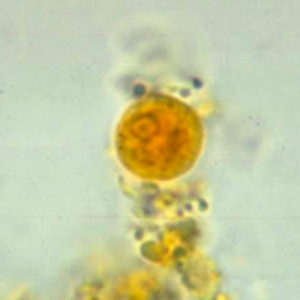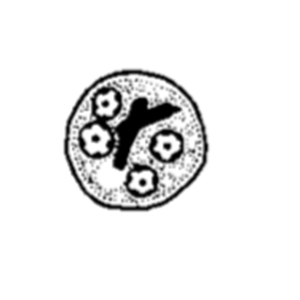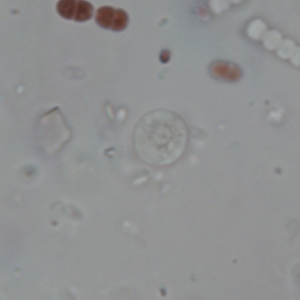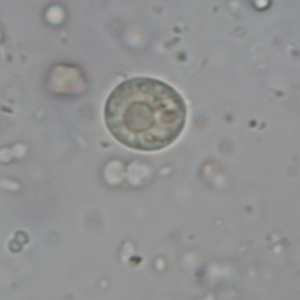Entamoeba harmanni is a species of amoeba which affects the cecum and colon of primates.
Epidemiology
Entamoeba hartmanni is a cosmopolitan parasite and is described in both Old-World Monkeys and Apes, including rhesus and Formosan rock macaques (Macaca mulatta and Macaca cyclopis) amongst others (Cogswell, 2007; Regan et al., 2014).
Description
Entamoeba hartmanni cysts are small (4 to 6 µm), round and stain with Lugol. They contain one to four subcentral nuclei with a voluminous eccentric endosome and peripheric granulomatous chromatin. They can also contain rare crystalloid bodies with rounded tips (Euzéby, 2008). Trichrome or iron-hematoxylin stain allow a more detailed visualization of the cysts.
Differential diagnosis
Differential diagnosis includes small-sized amoebas, other small-sized protozoa and non-parasitic structures:
- Among the small-sized amoebas, mainly Iodamoeba butschlii and Endolimax nana can be confused with Entamoeba hartmanni. However, butschlii has a more oval shape and presents a large iodophilic vacuole (Euzéby, 2008). On the other hand, E.nana presents one to four punctiform nuclei with a voluminous, eccentric, and irregular endosome without any perisome (Euzéby, 2008).
- Other small protozoa like Chilomastix mesnili, Retortamonas intestinalis, Enteromonas hominis and Giardia intestinalis can be confused with hartmanni. However, they are less round, often present organelles other than the nucleus, namely flagellae (Euzéby, 2008). A trichrome or iron hematoxylin stain may underline the cytoplasmatic details of the parasite and allow a better diagnosis.
- Non-parasitic elements like spores do not contain intracytoplasmatic structures and usually have a thicker and more refringent outer membrane (Petithory et al., 1995).
Clinical significance
Entamoeba hartmanni is not pathogenic for its hosts.
Prophylaxis and treatment
As a non-pathogenic parasite, contamination by Entamoeba hartmanni does not require treatment. Nevertheless, hygienic measures need to be taken in case of diagnosis in a captive setting.





